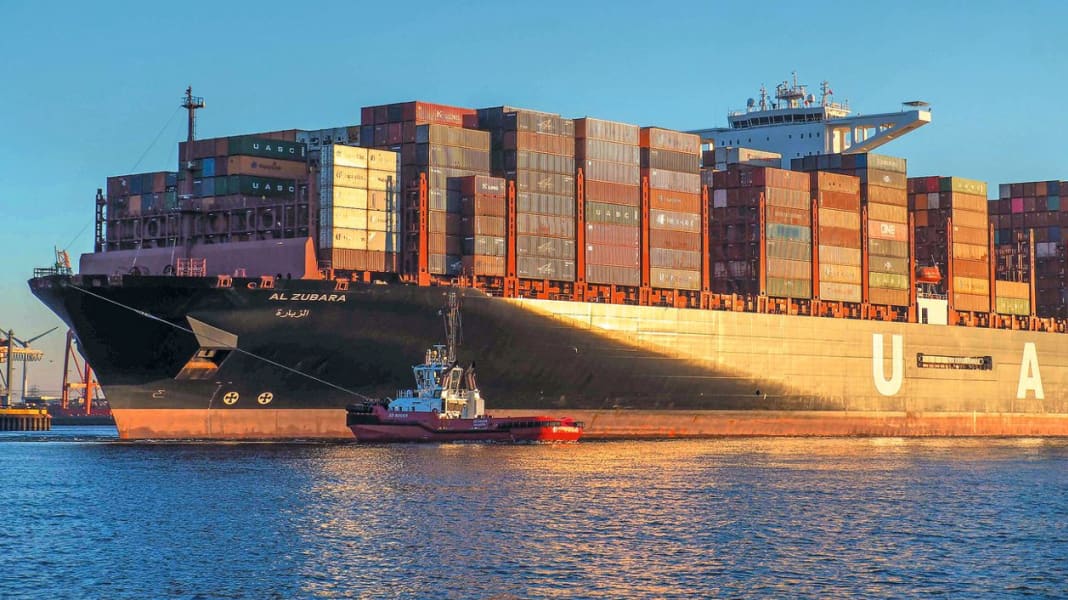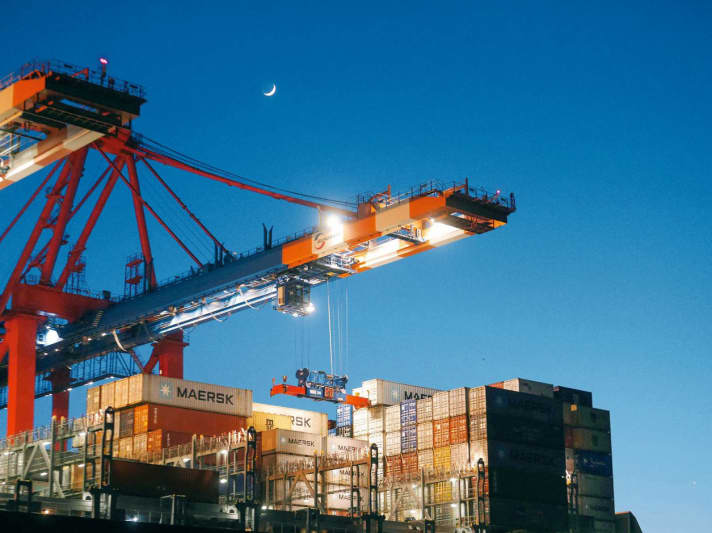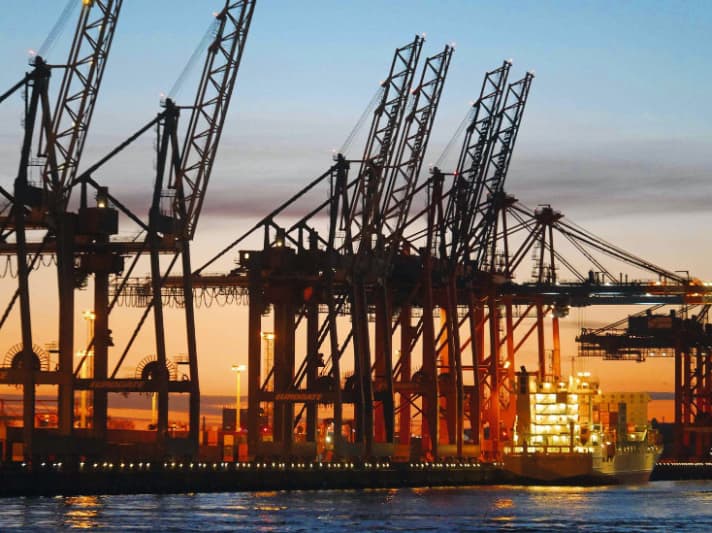
They go by the names "Bear", "Boxer", "Bison" and "Bulldog". What sounds like the bouncers and bouncers of the Port of Hamburg, the gateway to the world, is in fact the exact opposite: the ships arereal towing professionalseach capable of pulling 80 tonnes through the water.
And that's what they look like - bursting with power, real musclemen. A little pumped up. As if they've just come out of the gym.
We are talking about tugboats, the originals.Without these helpers in the port, the container giants would be - as the largest travelling constructions of man -pretty much at a loss. Once they entered the Elbe, they would be as clumsy and helpless as a sperm whale in a cage, unable to manoeuvre on their own in such a confined space. Let alone dock and cast off. High time for a small homage to the driving - or rather: pulling - force of the global economy.

Without tugboats, not only Hamburg's harbour would be in a deep sleep. The entire trade would come to a standstill.
I am a guest on board the ZP "Boxer", 24 metres long and half as wide. Launched in 2012. Aultra-modern specialised shipof the Kotug Smit Towage company. The shipping company's trademark: a bright red hull. Captain Rocco Voss welcomes me at the tugboat bridge in Neumühlen.
A lanky two-metre man of northern German appearance. Formerly a fisherman, he is nowTugboat captain for two decades. Always working in shifts, he says. Two weeks off, two weeks on standby.
"A good working rhythm, especially for the liver," he says with a grin.
"Look around, no inhibitions, what do you want to know?" Let's see: "Rocco," I ask, "is that perhaps an artist's name or a special captain's name?" After all, that could be the name of his tugboat. "No, no," he laughs. "Rocco and his brothers" was his parents' favourite film at the time. With Alain Delon. That's why. Then the captain shows me the "most important machine" on board: the coffee machine in the galley. "It never stands still," admits Rocco. "It provides the crew with what the tugboat provides for the harbour: the crucial thrust."

The engineer is responsible for the other engines on board:two Caterpillar dieselswhich together generate an impressive 5600 hp and thus aTractive force of 80 tonnes bring. Maximum manoeuvrability is ensured by two Rolls Royce rudder propellers, which can be swivelled all around. They can be manoeuvred from a seat on the bridge using a joystick and fingertip sensitivity.
The third man on board is a hired labourer from the Cape Verde Islands. The good - and from the shipping company's point of view "favourable" - soul. Boatswain and deckhand in one. He makes sure that the stomachs are full, the coffee is fresh, the deck is clean and the all-round glazing on the bridge is not stained or iced over by the spray.
The first customer is on its way: "At 4.30 p.m., we are to take the incoming 'Tokyo Triumph' from the Evergreen shipping company on the hook," says Captain Rocco. At the Hamburg state border at the Wedel combined heat and power plant, we will receive the ship and only accompany it for the time being - for safety reasons. "Escort service" is what it's called in towing jargon. Above a certain tonnage, this is mandatory on the Elbe. And an "ultra-large container ship" - the term really is that - such as the 365 metre long "Tokyo Triumph" easily falls into this category.
"In the event of an engine failure, the rudder action of such a giant immediately breaks down"explains Rocco. The ship's hull, including the container mountain, would then offer the wind a grateful surface to attack, which would easily double the sail area of a windjammer.
"And if 150,000 tonnes are suddenly left to their own devices on the Elbe, that's not good," says Rocco. "We're here to make sure that doesn't happen."

Today the container captain has booked three tugs, two aft and one at the bow.
The first hour of the operation still resembles a leisurely coffee trip. ZP "Boxer" chugs down the Elbe on autopilot, saving fuel: Övelgönne, Teufelsbrück, Blankenese and Falkenstein pass on the starboard side, Waltershof, Finkenwerder and the Airbus site on the port side. Shortly before Willkomm Höft, we put ourselves on standby at Schulau. Then the "Tokyo Triumph" comes into view. She slowly pushes up the Elbe in the backlight.
The tugs move into position and give way. "Boxer" escorts astern, virtually bumper to bumper. No trace of "Caution, keep your distance!". "If the steamer suddenly gets out of control, we have to be able to intervene quickly," says Rocco and routinely manoeuvres his suddenly rather tiny-looking ship into position under the towering stern.
The lines are only connected at Teufelsbrück, on the last few metres towards the quay, so to speak. Now the harbour pilot also goes on board over there. Even taking the caution line from above has its pitfalls: The thinner rope has to be used to haul the tug's fat towing hawser on board the container ship. To ensure that it reaches the bottom even in windy conditions, it is weighted down by the crew at the top.
"It's a disaster what's coming towards you these days," complains the engineer. Everything good comes from above: "We've already had massive shackles and wooden pegs crash onto the deck from a height of 30 metres."
Nobody questions the obligation to wear a helmet on board the tug. In another case, however, even the helmet is of little use:Material fatigue, a real horror scenario. Because even a cable as thick as an arm can break under tension.

The forces at work when the ends whip through the air are beyond good and evil: "A shackle weighing a few kilos from above is like a butterfly in comparison," says the captain. "Your helmet will fly off with your head."
Shortly afterwards, the time has come: the tugboat showdown is imminent. The "Tokyo Triumph" has to be turned in the current at the level of the Strandperle café and manoeuvred backwards to its berth. The harbour pilot gives the order for a somewhat rough water ballet.
Via radio, he becomes the chief conductor for the three tug captains - but without any artistic eccentricity: here, too, it is pure routine as the commands for the concerted operation are passed on channel 74, when which tug is to give how much thrust or slow down at the front or aft.
The towline on board the "Boxer" comes taut, very taut, and creaks menacingly, as if Goliath were on the rack. The ship shudders and snorts, the funnels smoke. Captain Rocco takes a drag on his e-cigarette and smokes with his tugboat. "Boy, boy, do we have to work hard again," he says dryly.

It could hardly be more ironic: small finger movements for a human, huge power transmission on the water. Rarely has so much tonnage been moved with just fingertip sensitivity in the truest sense of the word.
It is well known that faith can move mountains, at least among believers. We are at least as awestruck when the endless green wall above us slowly begins to turn. Rarely can the inertia of a large mass be experienced so vividly. The tugboat gets to work and suddenly the water is boiling all around us.
A flock of seagulls is already lurking above us. "They're happy," says Rocco. "Sometimes when we're manoeuvring, there's the famousBoxer' bouillabaisse." Eels and fish that get caught in the wings of the two azimuth thrusters under the fuselage and are served as morsels to the predatory birds.
Piece by piece, the "Tokyo Triumph" is manoeuvred backwards into Waltershof harbour. Past the other boats.
"The tighter, the better," says Captain Rocco, clearly ambiguous. He likes a challenge when things get tricky.
And loves his job. Pushing almost 400 metres of ship, more than 10,000 containers and 150,000 tonnes of weight between the other giants onto the pier - that's over-dimensioned work.

Two metres are still missing. "Boxer" now pushes directly from the side. Full contact - and all power ahead for the last few centimetres to the side into one of the largest parking spaces in the world.All in all, the manoeuvre takes almost three hours. You made it!
The sun is setting, the excursion boats are coming. And the machinist is a little annoyed. Who likes to be gawped at while they're working when they're over there partying with beer? Captain Rocco takes it more calmly: live and let live, he says. The harbour cruise also has to offer its guests something.
"Harbour up close. Front row." And Burchardkai is where the really big cinema takes place: "Giants of the Blue Hour" or something similar. What looks like David against Goliath should actually be called "David and Goliath" - together for the global economy. Yes, it's okay to clap!
Read the full article in the August 2019 issue of BOOTE.

